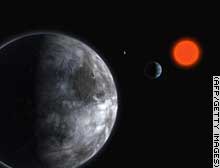“Because of its temperature and relative proximity, this planet will most probably be a very important target of the future space missions dedicated to the search for extraterrestrial life. On the treasure map of the Universe, one would be tempted to mark this planet with an X.” The big news today, of course: Astronomers announce the discovery of an earth-like planet, Gliese 581c, at the galactically tiny distance of 120 trillion miles (20.5 light years) away. (For the stargazers, Gliese 581 is a red dwarf “located in the northeastern part of constellation Libra.”) Of course, we still don’t know if we even have to go that far to find extraterrestrial life — Europa, Mars, Ganymede, and Callisto all still pose unresolved questions. Nevertheless, it’s an exciting moment in our history to discover the first planet far afield that might possibly be inhabited (and inhabitable)…and even more exciting to know that there’ll assuredly be many more to come. The stars, our destination!
Category: Search for Life
Water, Water Everywhere?
A faraway Jupiter-like gas planet, HD 209458b, is found (by some) to have water in its atmosphere. I saw this on Blivet on Friday and spent the weekend dreaming about it: If my sleeping brain can be trusted, HD 209458b has winged, eel-like space reptiles cavorting amidst the gaseous clouds there. Alas, my subconscious makes for a lousy exobiologist: “[A] Jupiter-like gaseous planet such as this one, as opposed to a rocky one like Earth, is highly unlikely to harbour any kind of life.” Well, damn.
Red Surf?
New photos released by NASA from the Mars Global Surveyor seem to suggest the possibility of surface water on Mars, which would make any attempt to visit — or colonize — the red planet considerably easier (although, obviously, it’s still no walk in the park.)
Martian Melee.
“‘We certainly have not convinced the community, and that’s been a little bit disappointing,’ said David McKay, a NASA biochemist and leader of the team that started the scientific episode.” Ten years later, CNN summarizes the simmering scientific dispute over a Martian meteorite, and the possible (albeit now seemingly quite unlikely) signs of life within.
Eye on Enceladus.
 “All these worlds are yours, except Europa…oh, and Enceladus.” In very big news, NASA announces that Cassini has found water plumes on Enceladus, Saturn’s moon. “This finding has substantially broadened the range of environments in the solar system that might support living organisms, and it doesn’t get any more significant than that…I’d say we’ve just hit the ball right out of the park.” What’s more, “unlike Europa, which researchers believe harbors a vast ocean beneath kilometers of thick ice, Enceladus’ water may be just below the surface.”
“All these worlds are yours, except Europa…oh, and Enceladus.” In very big news, NASA announces that Cassini has found water plumes on Enceladus, Saturn’s moon. “This finding has substantially broadened the range of environments in the solar system that might support living organisms, and it doesn’t get any more significant than that…I’d say we’ve just hit the ball right out of the park.” What’s more, “unlike Europa, which researchers believe harbors a vast ocean beneath kilometers of thick ice, Enceladus’ water may be just below the surface.”
New World Coming?
Using the relatively new technique of gravitational microlensing, astronomers discover their “most Earth-like planet yet”, orbiting a star in Sagittarius 20,000 light-years away. While this planet — currently named OGLE-2005-BLG-390Lb — is likely too cold for habitation, “‘we may predict with reasonable probability that microlensing will discover planets with masses like that of Earth at a similar distance from their stars and with comparable surface temperature,’ said study co-author Bohdan Paczynski from Princeton University.“
Ice, Ice, Baby.
Alright, stop, collaborate, and listen — Images sent back by the ESA’s Mars Express show the remants of icebergs once floating in a Martian Sea near the equator, and suggest that large ice blocks may well still exist just underneath the dusty surface (increasing both the chances of life on the Red Planet and the prospects for a successful manned mission.) Word to your mother.
Caverns of Mars.
After perusing “methane signatures and other possible signs of biological activity,” two NASA researchers claim there may well be life presently existing in subsurface Martian caves. We’re talking mitochondria, not Morlocks…but still, such a discovery would be exciting stuff, to say the least.
It’s Super, Thanks for Asking.
In something of a breakthrough, astronomers discover a “Super-Earth” that’s smaller, rockier, and closer — a mere 50 light years away — than the many gas giants previously discovered. Alas, with a surface temperature of approximately 1160 degrees Fahrenheit, it’s probably not the best spot for finding any kind of life. Still, baby steps.
Blue Planets, Red Planets.
The two NASA rovers have completed one facet of their mission, and the results are exciting: There was in fact water on Mars. And where there’s water, there’s…sea monkeys?

